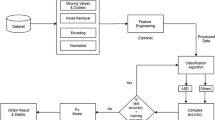Abstract
People with autism spectrum disorders have difficulties with communicating and socially interacting through facial expressions, even with their parents. The proposed approach applies person identification and emotion recognition. The objective of this work is to monitor and identify the people with autism spectral disorder based on sensors and machine learning algorithm. Our proposed system uses neurological sensor to collect the EEG data of patients and Q sensor for measuring stress level. The proposal integrates the facial recognition for identifying emotion recognition. The experimental results obtained from the proposed work performance evaluation are discussed, considering each for Autism Patient and the emotion labels. Proposed work shown the experimental results that can detect emotion with good accuracy compared to other classifiers. The proposed work achieves a 6% better accuracy for Proposed Model than Support Vector machine and 8% more accuracy than back Propagation algorithm.







Similar content being viewed by others
References
Christensen DL, Braun KVN, Baio J, Bilder D, Charles J, Constantino JN, Lee LC (2018) Prevalence and characteristics of autism spectrum disorder among children aged 8 years—autism and developmental disabilities monitoring network, 11 sites, United States, 2012. MMWR Surveill Summ 65(13):1
Dang X, Wei R, Li G (2017) An efficient movement and mental classification for children with autism based on motion and EEG features. J Ambient Intell Humaniz Comput 8(6):907–912
Fingert SB, Carter A, Pierce K, Stone WL, Wetherby A, Scheldrick C, Feinberg E (2019) Implementing systems-based innovations to improve access to early screening, diagnosis, and treatment services for children with autism spectrum disorder: an autism spectrum disorder pediatric, early detection, engagement, and services network study. Autism 23(3):653–664
Khowaja M, Robins DL, Adamson LB (2018) Utilizing two-tiered screening for early detection of autism spectrum disorder. Autism 22(7):881–890
Kushki A, Khan A, Brian J, Anagnostou E (2014) A Kalman filtering framework for physiological detection of anxiety-related arousal in children with autism spectrum disorder. IEEE Trans Biomed Eng 62(3):990–1000
Manocha A, Singh R (2019) An intelligent monitoring system for indoor safety of individuals suffering from autism spectrum disorder (ASD). J Ambient Intell Humaniz Comput. https://doi.org/10.1007/s12652-019-01277-3
Mollahosseini A, Chan D, Mahoor MH (2016) Going deeper in facial expression recognition using deep neural networks. In: 2016 IEEE Winter conference on applications of computer vision (WACV), pp 1–10
Rázuri JFG, Larsson A, Sundgren D, Bonet I, Moran A (2015) Recognition of emotions by the emotional feedback through behavioral human poses. Int J Comput Sci Issues 12(1):7–17
Sahi A, Rai P, Oh S, Ramasamy M, Harbaugh RE, Varadan VK (2014) Neural activity based biofeedback therapy for Autism spectrum disorder through wearable wireless textile EEG monitoring system. In: Nanosensors, Biosensors, and Info-Tech Sensors and Systems 2014. International Society for Optics and Photonics, vol. 9060, p. 90600D
Song R, Liu J, Kong XJ (2016) Autonomic dysfunction and autism: subtypes and clinical perspectives. N Am J Med Sci 9(4):173
Takano Y, Suzuki K (2014). Affective communication aid using wearable devices based on biosignals. In: Proceedings of the 2014 conference on Interaction design and children, pp 213–216
Author information
Authors and Affiliations
Corresponding author
Additional information
Publisher's Note
Springer Nature remains neutral with regard to jurisdictional claims in published maps and institutional affiliations.
Rights and permissions
About this article
Cite this article
Sivasangari, A., Ajitha, P., Rajkumar, I. et al. Emotion recognition system for autism disordered people. J Ambient Intell Human Comput (2019). https://doi.org/10.1007/s12652-019-01492-y
Received:
Accepted:
Published:
DOI: https://doi.org/10.1007/s12652-019-01492-y




